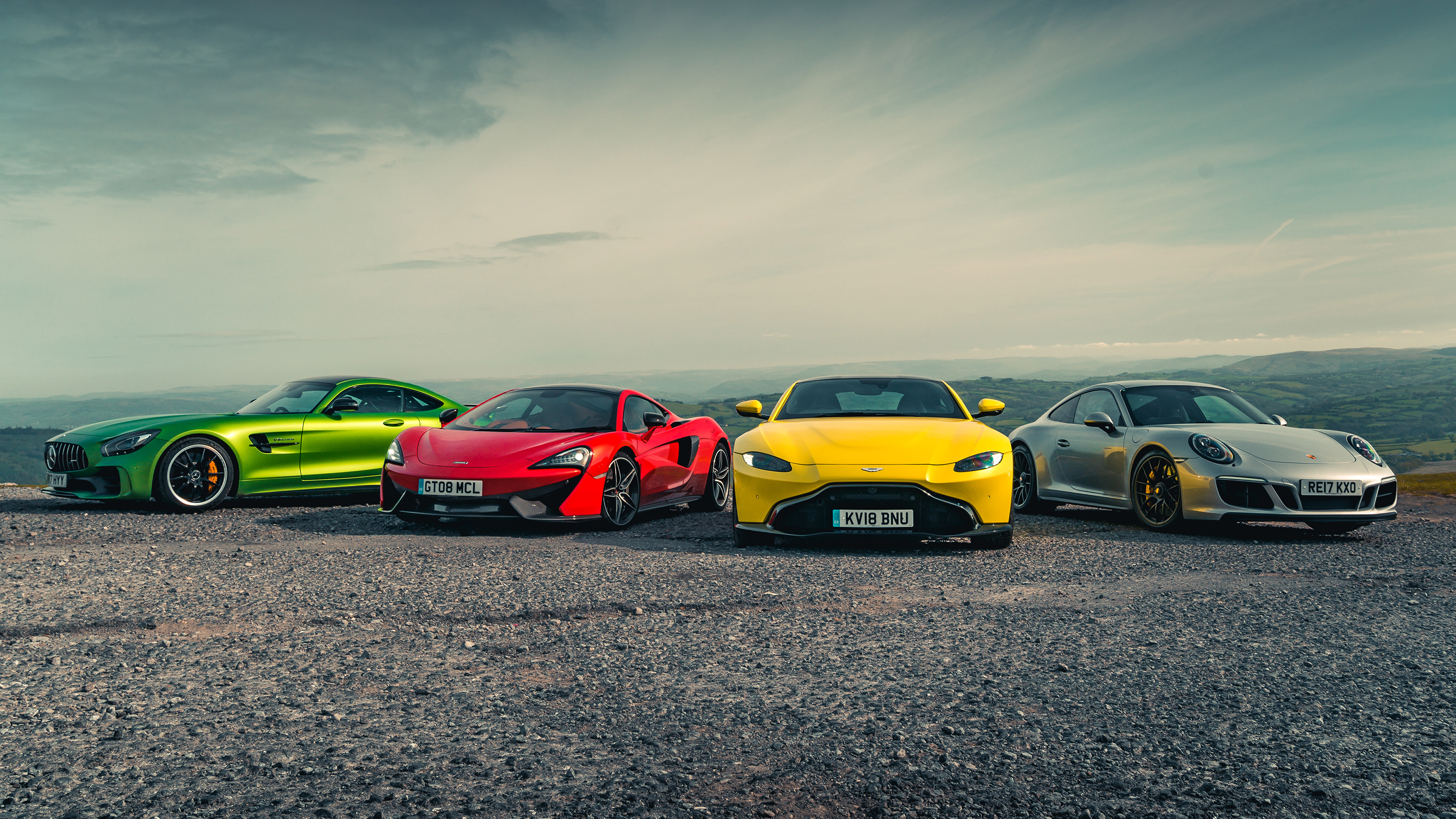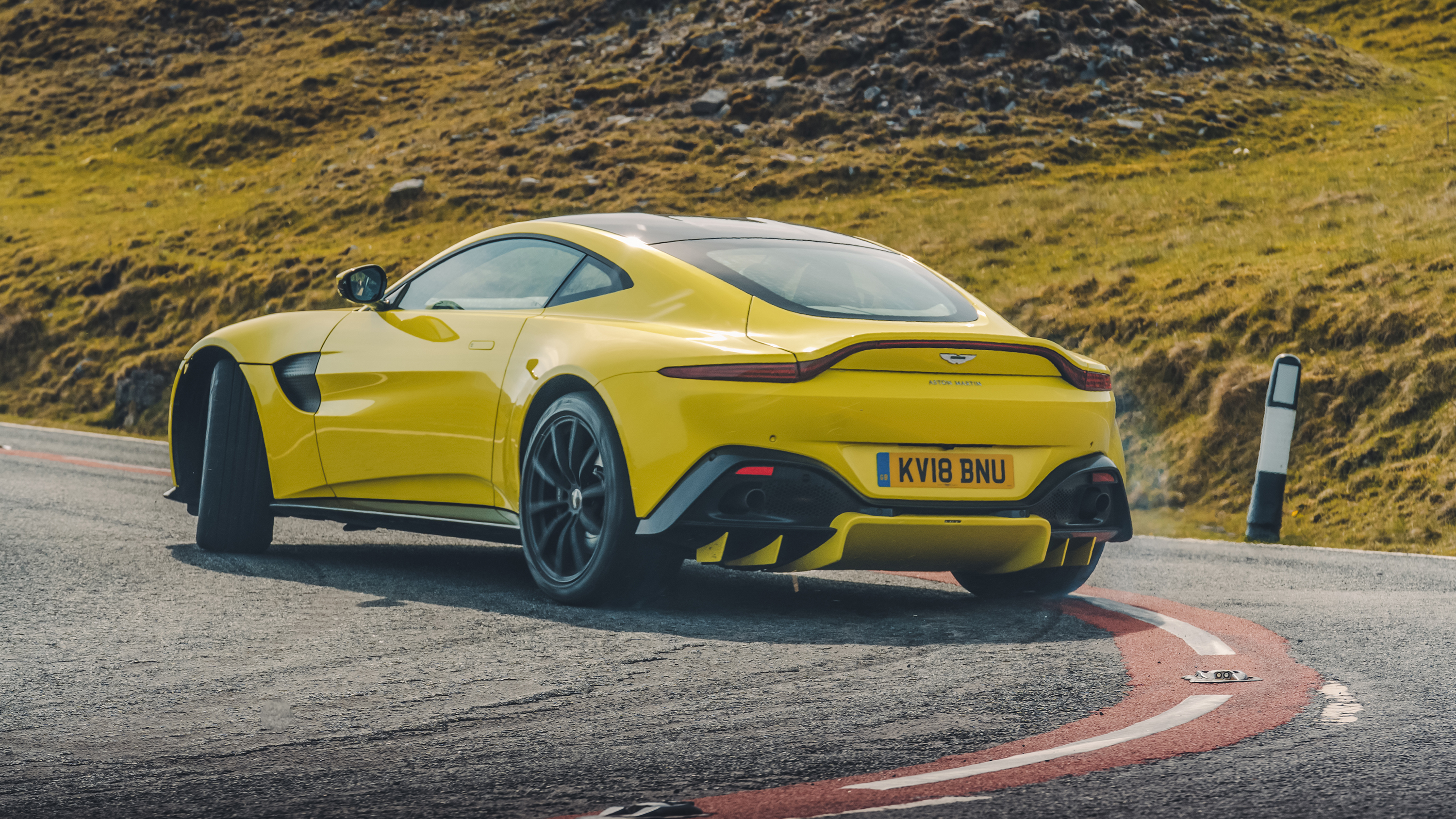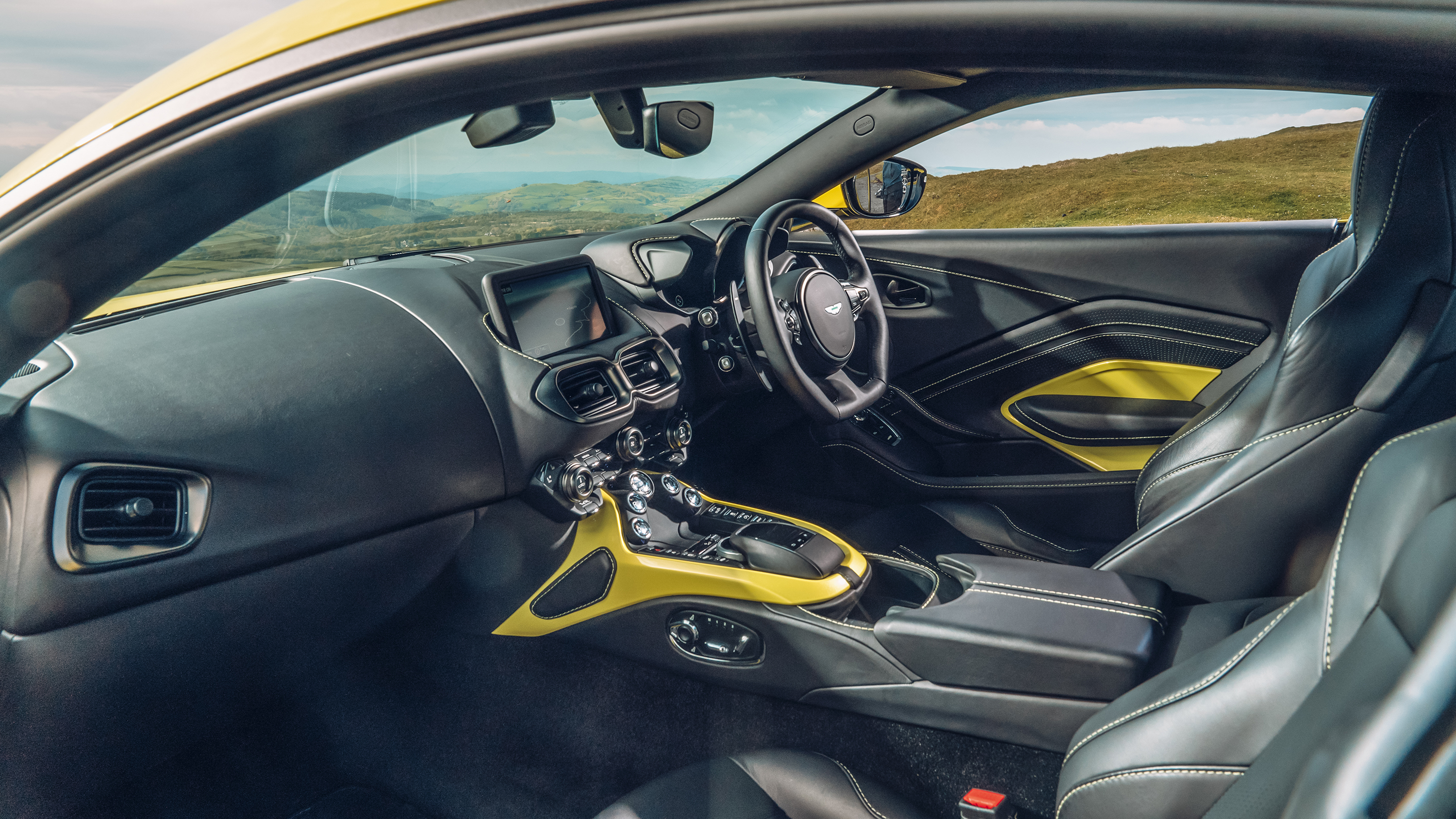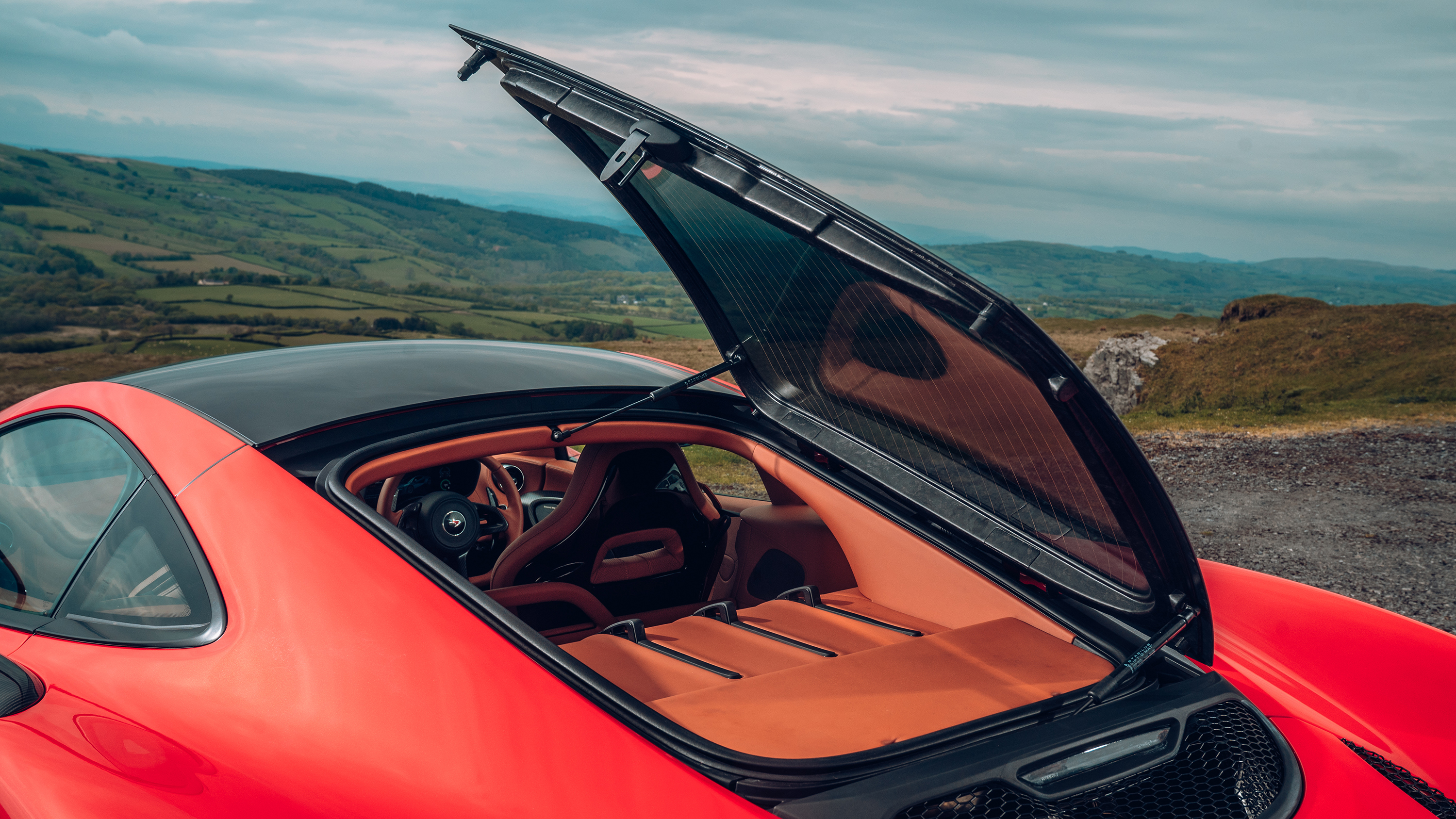
Aston Martin Vantage vs AMG GT R vs 911 GTS vs 570GT
The all-new, AMG-powered Vantage takes on Mercedes, Porsche and McLaren in a big sports car showdown
Taken in isolation, the new Aston Martin Vantage is a terrific car. But no car operates in isolation. Instead they compete. On power, price, philosopy, boot space, brand, looks, layout, you name it. Because, being capitalists at heart, we’ve learned that competition improves the breed.
Bottom line? The Vantage is competing for your money. Aston Martin wants you to invest in it, over and above all the other cars you could put your £120,000 into. And there’s a lot of them about. £120k is now the sports car/supercar bridging point: Audi R8, Mercedes-AMG GT, various Porsche 911s, McLaren 540C, BMW i8, Jaguar F-Type SVR, Lotus Evora GT430 – they’re all there or thereabouts.
Price would be the conventional way, the capitalist way, to sort this out, but it wouldn’t have told us enough about the Vantage. Instead we wanted to use rivals to frame it, to give us the fullest possible picture of what this car is, what it does and how it does it. So the most natural rival (the Jaguar F-Type SVR) gets left out. No matter. The Aston would have had it for breakfast.
Words: Ollie Marriage/Images: Mark Riccioni

The Aston is front-engined, rear-drive and features an AMG-sourced twin-turbo V8, just like the Mercedes-AMG GT R, although here it's less powerful, with 503bhp (the Merc has 577bhp). An AMG GT C would have been a closer match, but the GT R will show us how far Aston has pushed the aggression and excitement.
The Vantage is aiming to team sense of occasion with a measure of practicality and British craftsmanship, so step forward McLaren’s 570GT. And lastly it wants to be a bang-on daily driver, which brings it into contact with the Porsche 911. Here it’s the C4 GTS, the car Aston admits it’s benchmarked the Vantage against.
These cars don’t line up on power or price – the 444bhp, £100,781 Porsche (the least powerful and cheapest) has 133bhp less than the Merc-AMG, and costs £56,219 less than the McLaren, but as a group of cars to test the mettle of the new Aston Martin, it’s about as solid a defence as you could wish for.
A long motorway haul is as good an introduction as any. West Wales is the destination, 200 miles of motorway the first test. None cruises silently, a reminder that these are sports cars not GTs. Tyre noise is the most significant intrusion in all of them, but once you’re used to that it’s the Mercedes that continues to demand the most of you. Wearing the fattest tyres here it is the most distracted by camber and rut, the intimidation factor ramped up by the letterbox view out over the cricket pitch-length bonnet and the V8’s rumble and roar.
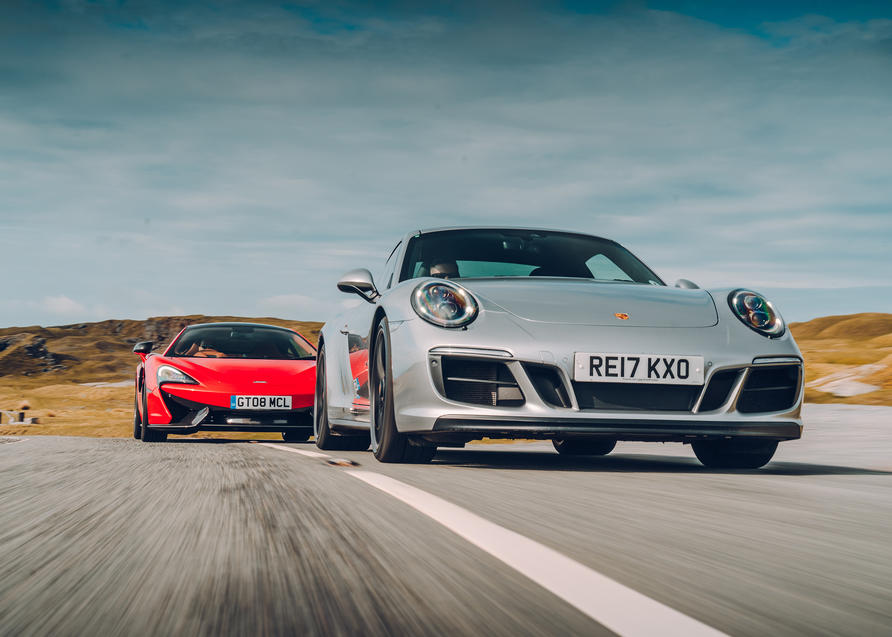
The Aston is more relaxing – you sit noticeably higher and more centrally in the car’s wheelbase, behind a shorter bonnet, but it doesn’t neutralise small suspension movements as ably as the Porsche. Even with the adjustable damper thumb switch left unpressed there’s a little vertical jiggle in the ride. The middle setting actually works best for the Aston in other situations. The 911, easy to see out of, easy to get on with, basically a lower-slung VW Golf (it does look a bit mainstream inside), hums through miles.
The McLaren makes more fuss, but it controls its movements beautifully. Shame the standard seats are a little firm in places and you’ll scrape your knuckles using the ill-located switches to adjust them. The best long-haul chairs belong to the Porsche – they’re the ones you sigh a little as you sink into – but none are poor, not even the GT R’s deep, fixed buckets.
The 570 GT has managed to get to the far end of the M4 having averaged 30mpg, joining the Aston (31mpg) and Porsche (34mpg) on the healthy side of the divide. Two days later the Porsche will be the only one able to hold its head high. 21.4mpg, where the Aston is slumped to 14.3.
From here on we’re not going to worry about economy, because roads like this aren’t conducive to hyper-miling. I’m still in the McLaren and loving how special it feels. Upward swinging doors and heels-dragging-on-tarmac seating position, the road experienced through a deep windscreen with a low scuttle. This not only creates a sense of speed, but a sense of supercar-ness that none of the others can match.
Top Gear
Newsletter
Thank you for subscribing to our newsletter. Look out for your regular round-up of news, reviews and offers in your inbox.
Get all the latest news, reviews and exclusives, direct to your inbox.
And as for they way it tackles roads… it’s light (the McLaren and Porsche both weigh significantly less than Aston and AMG) and you sit a long way forward, out where the front wheels are turning. That creates an immediacy and connection before you even turn the small, shapely, firm-rimmed steering wheel. And when you do you find it’s an accurate reflection of the way the 570 GT drives.
This one wears the £4,900 Sport pack with stiffer springs and it dances with the road. The word that keeps coming to me is ‘intimacy’, it flows and glides, treading lightly, narrow 225-section front tyres scudding over potholes that the Merc stomps through.
The Merc is a stomper. Initially you feel detached because the front end is so far ahead, but then you realise that, unlike the McLaren, it’s much more important to stay on top of what the rear end is doing. So there you are, sat where the axle squats, in exactly the right place to experience just how close the connection is between right foot and rear axle.
Every touch of the throttle triggers an over-reaction from the V8 that instantaneously manifests itself as an exhaust snarl, rear axle wriggle and leap forward. It’s exuberant and amusing, but behind the upper layers, there’s a steely-eyed focus, too.
The Porsche’s fluidity, the McLaren’s clarity, the AMG’s aggression: all three have clear, strong personalities
That front end is remarkable, not only for its grip, but the trust you quickly have in it. The steering doesn’t have the McLaren’s clarity and feedback, but the quick rack is sharp and accurate, eager to turn. Given where you sit, you’d have thought there would be a delay between front-end turn-in and rear-end power-out, but the balance at that mid point of the corner when it’s all loaded up and you’re neutral on the throttle is great.
It’s a world away from the snatchy, disappointing GT S. Avoid that if you’re set on an AMG GT. Go GT C, or, if you have a track appetite, GT R. Massively upgraded over the GT S, it’s a boisterous, addictive charger. And it makes the Aston feel rather tame. This was to be expected. The GT R makes everything else feel tame. But beyond that, the Aston only really comes to life when you go quite hard in it.
Trundle about and you get the sense you’re not quite scratching the surface of it – it’s not as satisfying to just drive as its rivals. The Porsche’s fluidity, the McLaren’s clarity, the AMG’s pomp and aggression: all have clear, strong personalities. The Aston isn’t laid bare in the same way – it takes more unearthing.
The harder you go, the better it gets. The problem – if you could call it one – is that the Aston is so composed that it doesn’t appear to be working hard. It gets itself down a road without much apparent effort.
It’s firmly sprung and accurate in a way no Aston has been, ever, and while it doesn’t have the snap and bite of the AMG, its natural balance is better, the Vantage seeming to pivot from a point somewhere slightly to the west of your left buttock. It drives how it looks: short and wide.
Width means there’s grip to lean on (and the Vantage isn’t afraid to lean a little), while the brief wheelbase heightens the sense of immediacy and is well-matched by the quick steering rack (just try to ignore the weird square steering wheel). You turn, the Vantage carves a consistent line, uncompresses smoothly as you exit and off you go up the next straight. It’s all rather undramatic, and even if you do push it, it remains composed and settled. It’s quietly satisfying, but not particularly extrovert.
It comes across as energetic. But it needs to hunker down into the tarmac a bit more – you want it to get down and dirty, but you sit a fraction high and the suspension is a little aloof. This is what the 911 does so well. It’s a small car and wraps around you, and has a real hunger for driving.
There’s a bit more movement in the dampers than the others and if you were being super-critical it gets slightly hazy around the limits of grip and the gearing is too long, but as a piece of gritty, tough, rewarding machinery; something with ability way beyond its familiar looks and four seats, it’s a superb car.

And because it doesn’t weigh much, the power deficit is no issue. It’s a fast, effective car, the 911. It’d be lovely if it was naturally aspirated of course, as there is a bit of turbo lag, but there’s more lag in the McLaren, whose engine has a plainer note than the guttural 911’s – at least until it hardens towards the top end, but by then all you can think about is the scorching acceleration, which nothing here can match. Nothing. The McLaren, when its 562bhp is truly uncorked, hits 100mph in 6.1secs. The Aston is over two seconds behind. Such is the potential pace you mostly surf the McLaren’s acceleration, where it’s less satisfying.
All do their best work when the needle is already hovering in the mid-range – it’s response we’re after here, not just torque. The Aston is the car that seems to be fighting the most mass, and it’s engine isn’t as scintillating and urgent as the GT R’s upgraded motor. That’s a proper, feral thing, a whipcrack V8 that sounds like it’s towing its own thunderstorm. The Aston’s noise all comes from in front – only when you stick it in Track mode and lift off do you get any contribution from the exhaust.
It’s a gentler application of the twin-turbo engine, and Aston has done a good job of making it feel and behave in a way that suits the car and disguises its origins. The eight-speed auto gearbox could – should – be snappier, especially on downchanges, where the others are all more eager.
A quick word on cabins. The Porsche is the benchmark for habitability, ergonomics, useability. There are seats in the back, the driving position is just so, it’s easy to place on the road without craning your nose. Compared to the others here it’s a car you shrug on and forget.

The Merc matches it for quality, kit and infotainment, but the high centre console wedges you in. It’s intimidating. The McLaren is more open, but isn’t underpinned by the same depth of quality as the Germans. There’s less flesh over the bones and beneath the skin. And that rear shelf is more for show than storage.
The Aston feels cramped inside – not just for space, but layout. It’s like all the dash features have been gathered in the middle of its face, so it appears to be gurning back at you. It’s ergonomically confused, and struggles to justify its price. The boot’s fine, it’ll cope with a weekend away, but it’s just not very pretty or logical inside. I’m much more convinced by the outside than I thought it would be, though.
As I said at the beginning, the plan here was to frame the Vantage against cars that reflect on it in different ways. That it’s not as aggressive as the GT R or as intimate and tactile as the 570 GT might be mildly disappointing, but it isn’t surprising – they’re more expensive, specialised cars with narrower focus.
Against the 911? It doesn’t have the Porsche’s bandwidth. You have to go digging to get the best from the Vantage and even then it doesn’t quite connect to the road as solidly, nor saunter through the daily tasks as easily.
That line I wrote earlier about the Vantage not having such an overt personality, not being as satisfying to just drive when your hair’s not on fire as its rivals holds true. Instead it treads the boundary between sharp sports car and good-natured GT without coming down on one side or the other. That may undermine it here, but I suspect it’s what Aston Martin intended and what Vantage buyers want.







